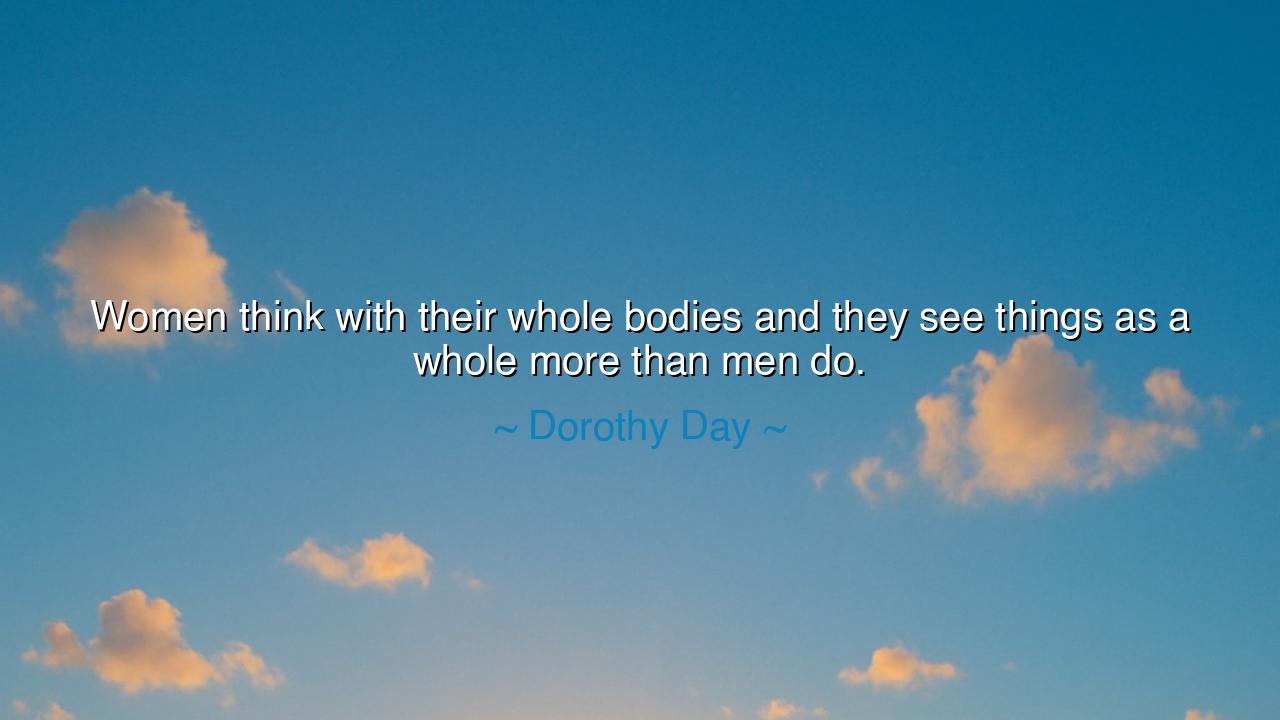
Women think with their whole bodies and they see things as a






The words of Dorothy Day, “Women think with their whole bodies and they see things as a whole more than men do,” ring with the ancient wisdom of one who had walked among both suffering and grace. In them is revealed a truth about perception and being—that the mind of woman is not divided, but integrated, flowing from body, heart, and spirit together. Where men may dissect, analyze, and separate, women often embrace, gather, and unify. This is not weakness, but a strength—an all-encompassing vision that beholds the world as a living whole rather than as fragments.
The origin of such an insight lies not in books alone, but in the long history of women’s lived experience. For centuries, women bore the burden of nurturing life, tending to the sick, keeping the household, and binding together the broken strands of community. Out of this daily labor arose a way of seeing: not through division, but through connection. To think with the whole body is to engage not only the mind, but also the heart that feels, the hands that labor, the womb that gives life, and the spirit that endures.
Consider the story of Clara Barton, the founder of the American Red Cross. In the chaos of war, where men calculated strategies and measured victories by territory, Barton looked upon the battlefield as a whole—seeing not numbers, but human lives, bodies torn yet souls unyielding. Her vision, born of compassion that engaged her entire being, enabled her to minister with courage where others hesitated. She is an embodiment of Day’s words: a woman who thought and acted with her whole body, and in doing so, saw more deeply than those who counted only the parts.
This wholeness of vision is a gift often overlooked by a world enthralled by analysis and separation. The female way of seeing reminds us that problems cannot always be solved in isolation, for all things are connected: body to soul, family to community, earth to heaven. To think as a whole is to perceive the harmony of existence, to hold contradictions without despair, to weave together threads that others cast aside.
Day’s words are also a call to honor this strength, rather than dismiss it. Too often has the wisdom of women been silenced as “emotional” or “irrational,” when in truth it is broader, deeper, and more encompassing than the narrow logic of separation. To value this way of seeing is to recover balance, to restore what has been lost in the dominance of fragmentary thought.
Let the generations remember: to think with the whole body is to think as life itself thinks—unified, interconnected, alive. The wisdom of women is not a lesser flame, but a guiding torch, illuminating the truth that all things are bound together. And in that unity lies the deepest kind of vision, the vision that sustains both the soul and the world.






TXNguyen thi xuan
This quote resonates with the idea that women’s intuition and emotional intelligence often play a significant role in their thinking. Women’s ability to process information with their entire being—emotions, physicality, and intellect—could give them a more comprehensive view of situations. But does this mean men lack this quality? Or do they express it differently? Is it possible for both genders to benefit from a more integrated approach to thinking and decision-making?
PHPhuc Hoang
Dorothy Day’s quote presents an interesting perspective on gender differences in thought. It seems to suggest that women, due to their physical and emotional experiences, have a more all-encompassing view of the world. I wonder if this statement oversimplifies things, though. Could it be that men also have a holistic view, but express it differently? Or is there something inherently in women’s experiences that lead them to think with their bodies and see the whole picture?
BTBao Tran
This quote makes me wonder whether women’s thinking is truly more holistic than men’s, or if society has just conditioned women to be more attuned to the interconnectedness of things. Could this be tied to women's roles historically being more centered around family and community, which require seeing the bigger picture? On the other hand, does this imply that men are more compartmentalized in their thinking, and if so, what are the consequences of that?
BHBinh Hoang
I find this quote intriguing because it seems to suggest that women have a more holistic approach to thinking and perceiving the world. This idea aligns with the notion that women often juggle multiple roles and responsibilities, which may foster a more integrated perspective. But is it really about gender, or could it be more about individual differences in how people approach life? Is there evidence supporting this view across various cultures and settings?